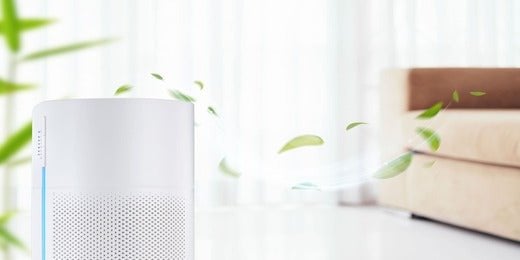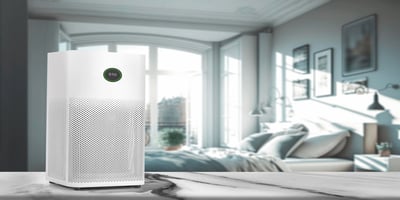Do Air Purifiers Help With Dust From Your Home?

Key Takeaways
- The Reality Check: Air purifiers capture airborne dust efficiently, but most household dust settles on surfaces within hours before it can be filtered.
- Mixed Results Are Normal: Some people see real symptom improvements, others get clean air readings with no health changes. Your specific dust sensitivity determines the outcome.
- Smart Systems Adapt: Unlike traditional fixed-speed units, smart purifiers like Sensibo Pure automatically adjust to actual dust levels rather than running blindly.
- Placement Beats Power: Central room location and unobstructed airflow matter more than expensive features. Most people position their units poorly.
- Costs vs Benefits Vary: $65-135 annual operating costs. Health benefits range from life-changing to negligible depending on individual dust sensitivities.
- The Dust Paradox: We obsess over invisible airborne particles while ignoring visible dust accumulating on every surface around us.
Household dust contains a complex mixture of dead skin cells, fabric fibers, pet dander, and microscopic debris that continuously circulates through indoor air. Dust in homes is composed of about 20-50% dead skin cells, with the rest consisting of plant pollen, human hairs, animal fur, textile fibers, and minerals from outdoor soil. HEPA filtration technology, as defined by the US EPA, can capture 99.97% of contaminants 0.3 microns and larger, making air purifiers effective tools for dust reduction. However, their success depends on proper sizing, placement, and filtration mechanisms that target the specific debris sizes found in household environments.
What Makes Household Dust a Health Threat
Chemical & Engineering News describes household dust as "a mix of sloughed-off skin cells, hair, clothing fibers, bacteria, dust mites, bits of dead bugs, soil particles, pollen, and microscopic specks of plastic". Research published in Environmental Sciences Europe shows that household dust composition varies significantly between homes, with organic components including human skin cells, pet dander, fabric fibers from clothing and furniture, and biological matter from dust mites. Inorganic elements encompass soil tracked indoors, combustion byproducts, and microscopic fragments from building materials.
Clinical studies demonstrate that prolonged exposure to household dust triggers inflammatory responses in respiratory tissue. Contaminants smaller than 10 microns bypass nasal filtration systems and deposit directly in lung airways. Matter under 2.5 microns reaches alveolar regions where gas exchange occurs, potentially causing oxidative stress and cellular damage.
Dust mites produce allergenic proteins, with these microscopic arthropods excreting waste measuring 10-40 microns, small enough to become airborne during normal household activities. The resulting inflammatory response creates chronic respiratory irritation that worsens over time without intervention.
How Filtration Systems Capture Contaminants
High-Efficiency Air (HEPA) filters operate through three distinct capture mechanisms that target different debris sizes. This multi-modal approach ensures successful dust removal across the entire size spectrum found in household environments.
|
Capture Method |
Target Size |
Mechanism |
Efficiency Rate |
|
Impaction |
0.5 microns |
Direct collision with filter fibers |
99.99% |
|
Interception |
0.1-0.5 microns |
Capture within fiber radius |
99.97% |
|
Diffusion |
0.1 microns |
Random molecular motion |
99.95% |
Impaction occurs when larger debris collides directly with filter fibers due to inertia. These contaminants cannot follow airflow streamlines around fiber obstacles and stick upon contact. This mechanism proves most successful for visible dust and larger allergens.
Interception captures medium-sized matter that passes close enough to filter fibers to be caught within their capture radius. Debris following airflow streamlines gets trapped when passing within one radius of a fiber surface.
Diffusion addresses the smallest contaminants through Brownian motion. These ultrafine materials move randomly due to molecular collisions, increasing their probability of contacting filter fibers despite following airflow patterns.
Calculating Required Dust Control Airflow
Successful dust control requires sufficient air circulation to process room air multiple times per hour. Industry standards suggest air purifiers should achieve 4-6 air changes per hour (ACH) for optimal debris removal in occupied spaces.
Clean Air Delivery Rate (CADR) Formula:
CADR = (Contaminant Removal Efficiency) × (Airflow Rate)
Room Size Calculation: Length × Width × Height = Total Volume
Required CFM = (Room Volume × Target ACH) ÷ 60 minutes
For dust removal, CADR ratings typically range from 100-400 cubic feet per minute (CFM), depending on unit size and fan capacity. Higher CADR values indicate faster debris removal but may produce increased noise levels.
Air purifier for dust placement significantly affects performance due to airflow patterns and contaminant distribution within rooms. Optimal positioning requires consideration of natural air currents, furniture obstacles, and dust generation sources. Central room location maximizes air circulation access from all directions, while elevated positioning takes advantage of thermal air currents and natural circulation.
Room airflow creates zones of varying contaminant concentrations. Areas with poor circulation, such as corners and spaces behind furniture, accumulate higher dust loads and benefit from targeted air movement.

Where Household Dust Originates
Understanding dust generation helps determine realistic expectations for air purification systems. Different sources produce varying debris sizes and quantities that affect filtration requirements.
Primary Generation Sources:
- HVAC Systems: Circulate accumulated contaminants and generate 2-50 micron debris through ductwork friction and filter bypass. Poor maintenance amplifies this source significantly.
- Textiles and Carpeting: Release fiber fragments 5-100 microns during normal use. Synthetic materials produce more airborne debris than natural fibers.
- Human Activity: Skin shedding produces 0.5-50 micron matter continuously. Physical activity increases generation rates exponentially.
- Pet Activity: Dander ranges 0.5-40 microns, with highest concentrations near pet sleeping and grooming areas.
Air purifiers for dust excel at capturing airborne contaminants but cannot address matter that has already settled on surfaces. This settled dust becomes problematic when disturbed by cleaning activities, foot traffic, or air currents. Removing dust from the air proves most successful when combined with source control measures that reduce generation at its origin.
Measuring Health Improvements
Study Parameters
Controlled trials measuring respiratory function improvements in homes with HEPA air purifiers demonstrate measurable benefits for individuals with dust-related sensitivities. Peak expiratory flow rates, a measure of lung function, show statistically significant improvements after 4-8 weeks of continuous air purification.
Documented Health Improvements from Research Studies:
- A 2021 clinical study with 38 subjects published in Allergologia et Immunopathologia found that HEPA air purifiers can decrease indoor house dust mite allergen and particulate matter levels while improving quality of life for allergic asthma patients. The study showed steady upward trends in Asthma Control Test scores in the treatment group using air purifiers for six months.
- A 2020 meta-analysis published in PMC found statistically significant improvements in Asthma Quality of Life Questionnaire scores and fractional exhaled nitric oxide levels in patients with predominantly mild to moderate asthma using air purification strategies.
- However, results vary between studies. A 2022 randomized controlled trial published in Annals of Allergy, Asthma Immunology testing Dyson air purifiers with 50 participants found significant air quality improvements but no significant improvements in asthma control or quality of life measures.
Smart Technology Integration for Automated Dust Management
An advanced air purifier for dust incorporates multiple sensors that detect contaminant concentrations and automatically adjust operation based on real-time air quality conditions. This automated response ensures optimal dust removal efficiency while minimizing energy consumption.
Sensor Technologies Include:
- Laser counters measuring debris 0.3-10 microns with high accuracy
- PM2.5 sensors detecting fine matter concentrations
- Air quality indicators providing real-time feedback on dust levels
- Filter monitoring tracking loading and replacement needs
Smart systems differentiate between different types of airborne contaminants, adjusting fan speeds and filtration settings based on specific pollutants detected.
Comprehensive Dust Management with Sensibo Pure

The Sensibo Pure Smart Air Purifier integrates multi-stage HEPA filtration with intelligent sensing technology designed specifically for dust removal. Its pollution-sensing capabilities detect contaminants across the full size spectrum, automatically adjusting operation to maintain optimal air quality.
Key specifications include multi-stage HEPA filtration removing dust, pollen, smoke, and microscopic debris. Built-in air quality sensors detect and eliminate airborne contaminants automatically. Smart app control provides real-time air quality monitoring and notifications. Voice assistant compatibility enables hands-free operation through Alexa, Google Home, and Siri.
The PureBoost™ technology represents a significant advancement in dust control, activating connected AC systems to increase air circulation when pollution levels rise. This integration between air purification and HVAC systems maximizes dust removal efficiency throughout entire living spaces.
Investment Returns from Air Purification
Investment in air purification for dust control generates measurable economic returns through reduced healthcare costs and improved quality of life. Studies tracking families with dust-related respiratory issues show significant decreases in medical expenses after installing HEPA air purifiers.
Quantified Economic Benefits from Research:
Studies tracking families with dust-related respiratory issues show measurable economic returns through reduced healthcare costs. Research indicates potential reductions in medication use and medical visits for individuals with properly managed indoor air quality.
Annual Operating Costs: Electricity consumption ranges $15-35 per year for continuous operation. Filter replacement costs $50-100 annually depending on usage and air quality. Maintenance requires minimal costs for periodic cleaning and inspection.
Energy-efficient models with smart sensors optimize power consumption by adjusting operation based on actual dust levels rather than running continuously at maximum settings.
Performance Limitations and Realistic Expectations
Air purifiers successfully remove dust from the air, but cannot address all aspects of household dust management. Understanding these constraints helps set realistic expectations and develop comprehensive dust control strategies.
Operational Constraints: Cannot remove contaminants that have already settled on surfaces. Limited to spaces with adequate air circulation. Heavy debris settles faster than air circulation can capture them. Cannot prevent new dust creation from ongoing activities.
Multiple factors influence air purifier performance for dust removal, creating variability in real-world performance compared to laboratory testing conditions. Room size and layout affect coverage, with larger or irregularly shaped rooms reducing effectiveness. Air sealing quality influences results, as leaky buildings allow continuous dust infiltration. Occupancy patterns matter, since higher activity levels increase dust generation rates. Maintenance frequency proves critical, as clogged filters significantly reduce performance.
Regular maintenance, proper sizing, and realistic expectations ensure optimal dust reduction benefits from air purification systems.
FAQ
Do air purifiers actually remove dust from the air effectively?
Yes, according to EPA standards, HEPA air purifiers can remove 99.97% of airborne dust contaminants 0.3 microns and larger. However, they only address airborne matter, not debris that has settled on surfaces. Performance depends on proper sizing, placement, and continuous operation.
What size air purifier do I need for dust control in my room?
Calculate room volume (length × width × height) and choose an air purifier for dust with a Clean Air Delivery Rate (CADR) that provides 4-6 air changes per hour. For a 300 square foot room with 8-foot ceilings, look for a CADR rating of 160-240 CFM.
How long does it take for an air purifier to reduce dust levels?
Large contaminants (2.5 microns) show 70-85% reduction within 24 hours of continuous operation. Fine matter (0.3-2.5 microns) requires 48-72 hours for optimal reduction. Ultrafine debris may take up to a week for maximum results.
Can air purifiers help with dust allergies and asthma?
Clinical studies show HEPA air purifiers can improve quality of life for allergic asthma patients and reduce indoor allergen levels. However, research results are mixed, with some studies showing significant improvements while others find no measurable clinical benefits despite improved air quality.
How often should I replace air purifier filters for dust removal?
HEPA filters typically require replacement every 6-12 months depending on dust levels and usage. Smart purifiers with filter monitoring provide replacement alerts based on actual filter loading rather than time-based schedules.
Where should I place an air purifier for maximum dust removal?
Position the unit in a central location away from walls and furniture to maximize air circulation. Avoid corners, behind furniture, or near dust-generating sources. Elevated placement takes advantage of natural air currents for better contaminant capture.
Are expensive air purifiers better at removing dust than cheaper models?
Price doesn't always correlate with dust removal capability. Focus on HEPA filtration certification, appropriate CADR ratings for your room size, and smart features that optimize operation. The most expensive unit may be oversized or include unnecessary features for basic dust control.



































.jpg?height=200&name=photo_2023-12-29_20-01-46%20(1).jpg)


